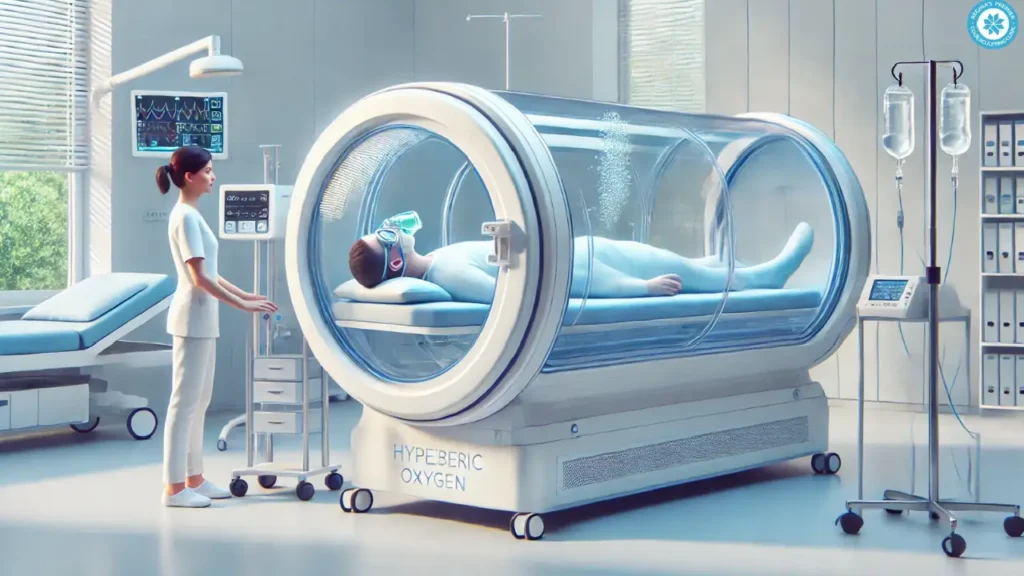Imagine stepping into a special chamber that pumps pure oxygen to help your body heal faster. That’s the magic of Hyperbaric Oxygen Therapy (HBOT) and pressurized chamber technology! In 2025, these tools are making waves in healthcare, helping people recover from wounds, infections, and even brain injuries. Whether you’re curious about Hyperbaric Oxygen Treatment or want to understand how pressurized chambers work, this guide breaks it down in simple terms. We’ll cover six practical strategies to explore this technology, its benefits, and how it’s changing lives. Let’s dive into the world of Hyperbaric Oxygen Therapy!
What Is Hyperbaric Oxygen Therapy and How It Works
Hyperbaric Oxygen Therapy (HBOT) is a treatment where you breathe pure oxygen inside a pressurized chamber. The chamber increases air pressure to 1.5–3 times higher than normal, helping your lungs take in more oxygen. This extra oxygen travels through your blood to your tissues, speeding up healing. Think of it like giving your body a supercharged oxygen boost!
In a pressurized chamber, the air is usually set to 2–3 atmospheres (ATA), which is like being 33–66 feet underwater. You lie down or sit comfortably, breathing 100% oxygen through a mask or hood. Sessions last about 90 minutes to 2 hours, and you might need 20–60 sessions depending on your condition. For example, if you have a stubborn wound, Hyperbaric Oxygen Treatment can help new skin grow faster by delivering oxygen to the damaged area.
To start with Hyperbaric Oxygen Therapy, you’ll need a doctor’s prescription. Hospitals and clinics like Mayo Clinic offer pressurized chamber, and some even have portable options for home use. It’s a safe, FDA-approved treatment for conditions like diabetic foot ulcers and carbon monoxide poisoning, but always check with a doctor first.
How Pressurized Chambers Boost Healing
Pressurized chambers are the backbone of Hyperbaric Oxygen Therapy. They work by creating a high-pressure environment that lets your body absorb more oxygen than it would normally. This process, based on Henry’s Law, means more oxygen dissolves into your blood plasma, reaching areas with poor blood flow. It’s like giving your cells a power-up to repair themselves.
For example, if you have a wound that won’t heal, a pressurized chamber floods the area with oxygen, reducing swelling and helping new blood vessels grow. This is called angiogenesis, and studies show it can increase capillary density by up to 40%. Hyperbaric Oxygen Treatment also fights infections by making it harder for bacteria to survive in an oxygen-rich environment.
To use a pressurized chamber, you’ll either enter a monoplace chamber (for one person) or a multiplace chamber (for several people). Monoplace chambers are like clear tubes where you lie down, while multiplace chambers are like small rooms where you wear a mask. Both deliver Hyperbaric Oxygen Treatment, but your doctor will choose the best one based on your needs.
Key Applications of Hyperbaric Oxygen Treatment
Hyperbaric Oxygen Treatment is used for a wide range of health issues, and its applications are growing in 2025. The FDA has approved it for 14 conditions, including:
- Decompression sickness: Common in scuba divers, where pressurized chambers shrink gas bubbles in the blood.
- Diabetic foot ulcers: Hyperbaric Oxygen Therapy speeds up healing by boosting oxygen to damaged tissues.
- Carbon monoxide poisoning: Hyperbaric Oxygen Treatment removes toxins from the blood.
- Chronic wounds: Helps heal burns or infections that resist other treatments.
Beyond FDA-approved uses, Hyperbaric Oxygen Therapy is being explored for brain injuries, stroke recovery, and even cancer support. For instance, new studies suggest it may weaken cancer tumors by creating an oxygen-rich environment, making other treatments like chemotherapy more effective. However, these uses are still under research, so always consult a doctor.
To benefit from Hyperbaric Oxygen Treatment, find a clinic with accredited pressurized chambers. Your doctor will create a treatment plan, which might involve daily sessions for a few weeks. Each session in a pressurized chamber is like a mini-healing boost for your body.
Choosing the Right Pressurized Chamber for You
Not all pressurized chambers are the same, and picking the right one is key for effective Hyperbaric Oxygen Therapy. There are two main types:
- Monoplace chambers: Built for one person, these are compact and filled with pure oxygen. They’re great for home use or small clinics.
- Multiplace chambers: Larger rooms for multiple people, where you breathe oxygen through a mask. These are common in hospitals.
For example, if you’re getting Hyperbaric Oxygen Treatment at home, a monoplace chamber might be best because it’s easier to set up. Clinics like Michigan Medicine use multiplace chambers for group treatments, which can feel more social, like sitting in an airplane cabin with others.
When choosing a pressurized chamber, check its pressure range (1.5–3 ATA is standard) and safety features, like fire-resistant materials. Avoid “soft” or mild chambers for serious conditions, as they don’t reach high enough pressure for true Hyperbaric Oxygen Treatment. Always go to an accredited facility, as unapproved chambers can be unsafe, with risks like fires or ineffective treatment.
Safety Tips for Hyperbaric Oxygen Therapy
Hyperbaric Oxygen Therapy is generally safe, but there are a few risks to know about when using a pressurized chamber. The most common issues are ear pressure (like on an airplane) and claustrophobia. In rare cases, too much oxygen can cause seizures, or rapid pressure changes can lead to lung or ear injuries. Here’s how to stay safe:
- Choose an accredited facility: The FDA warns against unapproved chambers, which can cause fires or suffocation. Stick to hospitals or clinics certified by the Undersea and Hyperbaric Medical Society.
- Follow prep rules: Remove metal objects, like jewelry, to avoid sparks in the oxygen-rich pressurized chamber. Wear hospital-approved gowns.
- Manage ear pressure: Yawn, swallow, or chew gum during Hyperbaric Oxygen Treatment to ease ear discomfort.
- Check with your doctor: Avoid Hyperbaric Oxygen Therapy if you have an untreated pneumothorax (collapsed lung), as it’s a serious risk.
For example, before a session, your healthcare team will check your vitals and ensure you’re ready. During Hyperbaric Oxygen Treatment, staff monitor you closely to keep things safe and comfortable.
Future Trends in Pressurized Chamber Technology
In 2025, pressurized chamber technology is getting smarter and more accessible. New trends are making Hyperbaric Oxygen Therapy even more exciting:
- Portable chambers: Companies like OxygenArk are designing smaller, safer pressurized chambers for home use, though they’re best for mild conditions like athletic recovery.
- Advanced safety features: New pressurized chambers have built-in oxygen concentrators to reduce fire risks, unlike older models that used external tanks.
- Research expansion: Studies are exploring Hyperbaric Oxygen Treatment for conditions like traumatic brain injuries and cancer, with promising early results.
- Affordable options: Costs for Hyperbaric Oxygen Therapy are dropping, with sessions ranging from $200–$1,250, and many insurance plans, including Medicare, covering FDA-approved treatments.
For example, clinics like Elixir Health and Wellness are pairing pressurized chambers with digital monitoring systems to track patient progress in real-time. This makes Hyperbaric Oxygen Treatment more precise and tailored to your needs.
Conclusion: Embrace Hyperbaric Oxygen Therapy in 2025
Hyperbaric Oxygen Therapy and pressurized chamber technology are changing the way we heal in 2025. From treating stubborn wounds to exploring new uses like cancer support, Hyperbaric Oxygen Treatment offers hope for many. These six strategies—understanding HBOT, using pressurized chambers, exploring applications, choosing the right chamber, staying safe, and looking at future trends—give you a clear path to make the most of this technology.
Ready to try Hyperbaric Oxygen Therapy? Talk to your doctor, find an accredited clinic with a pressurized chamber, and start your healing journey. Whether it’s a monoplace or multiplace chamber, Hyperbaric Oxygen Treatment could be the boost your body needs. Start exploring today and see how this technology can transform your health in 2025!








